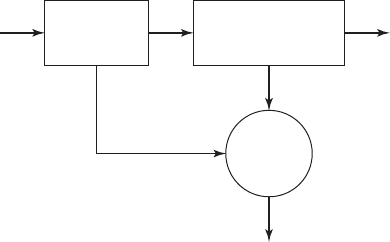Water and Wastewater Engineering
Подождите немного. Документ загружается.

WASTEWATER PLANT RESIDUALS MANAGEMENT 27-53
Heat Treatment
Another conditioning approach is to heat the sludge at high temperatures (175 C to 230 C) and
pressures (1,000 to 2,000 kPa). Under these conditions, much like those of a pressure cooker,
water that is bound up in the solids is released, improving the dewatering characteristics of the
sludge. Heat treatment has the advantage of produ
cing a sludge that dewaters better than chem-
ically conditioned sludge. The process has the disadvantages of relatively complex operation,
high maintenance requirements, and the creation of highly polluted cooking liquors (soluble
BOD may exceed 5,000 mg/L) that when recycled
to the treatment plant impose a significant
added treatment burden. In addition, the process has high capital and operating costs. For these
reasons, very few new facilities have been built in recent years (Metcalf & Eddy, 2003) .
27-11 DEWATERING
Many of the method s for dewatering biomass sludges are the same as those used to dewater
water treatment plant residuals. Their basic mechanism of operation is discussed and illustrated
in Chapter 15. The following discussion focuses on the particular considerations in application
to d
ewatering biomass sludge. In the past, vacuum filtration was the predominant dewatering
device for municipal sludge. It has been replaced by alternative mechanical dewatering equip-
ment (Metcalf & Eddy, 2003). Vacuum filters, reed beds, and lagoons are not considered in this
discussion.
Sludge Drying Beds
The most popular method of sludge dewatering in the past has been the use of sludge drying
beds. These beds are especially popular in small plants because of their simplicity of operation
and maintenance. In 1979, 77 percent of all United States wastewater treatment plants utilized
drying beds; one-half of all the munic
ipal sludge produced in the United States was dewatered
by this method (U.S. EPA, 1979). Most of these plants are located in small- and medium-sized
communities, with an average flow rate of less than 8,000 m
3
/ d. Some larger cities, such as
Albuquerque, Fort Worth, Texas, Phoenix, and Salt Lake City, use sand drying beds. Although
the use of drying beds might be expected in the warmer, sunny regions, they are also used in
several large facilities in northern climates.
Operational procedures
common to all types of drying beds involve the following steps:
1 . Pump 0.20 to 0.30 m of stabilized liquid sludge onto the drying bed surface.
2. Add chemical conditioners continuously, if conditioners are used, by injection into the
sludge as it is pu
mped onto the bed.
3. When the bed is filled to the desired level, allow the sludge to dry to the desired final
solids concentration. This concentration can vary from 18 to 60 percent, depending on
several factors, including type of sludge, processing rate needed, and degree of dryness
requ
ired for lifting. Nominal drying times vary from 10 to 15 d under favorable condi-
tions, to 30 to 60 d under barely acceptable conditions.
4. Remove the dewatered sludge either mechanically or manually.
5. Repeat the cycle.

27-54 WATER AND WASTEWATER ENGINEERING
Sand drying beds for wastewater sludge are constructed in the s ame manner as water treatm ent
plant sludge-drying beds as discussed and illustrated in Chapter 15. Typical loading rates are
given in Table 27-17 .
Sand drying beds can be built with or without a roof. Newly constru
cted beds are designed
for mechanical sludge removal.
Centrifugation
In addition to the solid-bowl centrifuge discussed in Chapter 15, a “high-solids” centrifuge is
used to dewater biosolids. The high-solids centrifuge is a modification of the solid-bowl configu-
ration. The modification primarily consists of a slightly longer bowl length, a lower differential
bowl speed to increas
e residence time, and a modified scroll.
Dosage rates for polymers range from 0.1 to 7.5 g/kg of sludge measured on a dry solids
basis. Higher polymer doses may be required for the high-solids centrifuge. Typical performance
data are given in Table 27-18 .
Source: Metcalf & Eddy, 2003.
Type of biosolids
Sludge loading rate,
kg dry solids/m
2
· y
Primary, digested 120–150
Primary and waste activated, digested 60–100
TABLE 27-17
Typical loading rates for open sludge drying beds
Source: Metcalf & Eddy, 2003; U.S. EPA, 1979.
Solids capture, %
Type of sludge Cake solids, %
Without
chemicals
With
chemicals
Untreated primary
Alone 25–35 75–90 95
With air activated sludge 12–20 55–65 92
Waste activated sludge 5–15 60–80 92
Anaerobically digested
Primary
25–35 65–80 92
Primary and activated sludge 15–20 50–65 90
Aerobically digested
Waste activated sludge 8–10 60–75 90
TABLE 27-18
Typical dewatering performance for solid-bowl centrifuges

WASTEWATER PLANT RESIDUALS MANAGEMENT 27-55
Continuous Belt-Filter Presses
The continuous belt-filter presses (CBFP) used in treating wastewater sludges is the same as that
used for water treatment plant sludges (Chapter 15). It is one of the predominant dewatering de-
vices used in the United States today.
The CBFP is successful with many normal mixed s
ludges . Typical dewatering results for
various types of sludges are given in Table 27-19 .
C B FPs are available in belt widths from 0.5 to 3.5 m. The most common size used for
munic ipal applications is 2.0 m. Belt speeds vary from 1.0 to 2.5 m/min. At low feed-solids
c
oncentrations, the capacity of the gravity drainage zone usually is limiting and belt speed must
be reduced to maximize gravity drainage. As the feed solids concentration increases, a point is
reached where the solids loading and thickness of the cake becomes controlling. At this point, the
TABLE 27-19
Typical performance data for a belt filter press
a
Polymer needs based on high molecular weight polymer (100% strength, dry basis).
b
Ratio is based on dry solids for the primary and WAS.
Source: WEF, 1998.
Loading per
metre belt width Cake solids, %
Type of sludge
Dry feed
solids,% L/min kg/h
Dry polymer
a
,
g/kg dry solids Typical Range
Raw primary (P) 3–7 110–190 360–550 1–4 28 26–32
Waste activated
sludge (WAS)
1–4 40–15045–180 3–10 15 12–20
P WAS (50:50)
b
3–6 80–190 180–320 2–8 23 20–28
P WAS (40:60)
b
3–6 80–190 180–320 2–10 20 18–25
P trickling filter
(TF)
3–6 80–190 180–320 2–8 25 23–30
Anaerobically
digested:
P 3–7 80–190 360–5502–5 28 24–30
WAS 3–4 40–15045–135 4–10 15 12–20
P WAS 3–6 80–190 180–320 3–8 22 20–25
Aerobically
digested:
P WAS,
unthickened
1–3 40–190 135–225 2–8 16 12–20
P WAS
(
50:50),
thickened
4–8 40–190 135–225 2–8 18 12–25
Oxygen activated
WAS
1–3 40–150 90–180 4–10 18 15–23

27-56 WATER AND WASTEWATER ENGINEERING
loading rate must be reduced to prevent sludge from being forced out of the edges of the CBFP
(Task Committee, 1988).
E xample 27-8 illustrates the method for s electing an appropriate size CBFP from manufac-
turer’s data like that shown in Table 27-20 .
Example 27-8. Select a CBFP to dewater an anaerobic digester sludge. The sludge is
primary
plus waste activated sludge that has a solids concentration of 2.5% and a specific gravity of 1.02.
The design sludge flow rate is 171.2 m
3
/ d . The plant managers wish to operate on a two-shift
basis, that is, 16 h/d to minimize labor costs. Using Table 27-20 , select an appropriate CBFP belt
width.
Solution:
a . Convert the sludge flow rate to units compatible with Table 27-20 taking into account
that dewatering will take place over the 16 h workday.
171 2
16
10 7
3
3
.
.
m /d
h/d
m /h
b. From Table 27-20 , select a 1.0 m width belt as a first trial.
c. Compute the solids loading rate using Equation 15-9 from Chapter 15.
MQ SP
sl sl sl s
()()()()
()(
10 7 1 000
3
.,m /h kg/mm or kg/h
3
102 0025 272 85 273)( )( ).. .
This is within the range of 125–510 kg/h specified by the manufacturer.
d. Check the hydraulic and solids loading.
Note: These presses are representative but do not represent actual choices. Actual
manufacturers’ data must be used for real world design.
Hydraulic loading, Solids loading, Belt width,
m
3
/h kg/h m
1–3 25–120 0.5
3–5 120–200 0.75
5–20 125–510 1.0
20–30 510–815 1.5
30–40 765–1,070 2.0
40–50 1,020–1,275 2.5
50–60 1,275–1,530 3.0
TABLE 27-20
Typical continuous filter press manufacturer’s data

WASTEWATER PLANT RESIDUALS MANAGEMENT 27-57
Hydraulic:
10 7
10
10 7
3
3
.
.
.
m /h
m belt width
m /h m or 11783.L/min m
Solids loading:
273
10
273
kg/h
m belt width
kg/h m
.
The hydraulic loading is within the typical ranges of 80–190 L / min · m, and the solids
loading is within the typical range of 180–320 kg/h · m given in Table 27-19 .
Comments:
1 . This is a trial selection. Other factors to be considered are polymer addition and the low %
solids of the feed.
2. For existing facilities, the use of pilot units is highly
recommended.
Filter Press
Both the recessed plate and diaphragm filter presses described in Chapter 15 are used to dewater
biosolids sludges. Advantages cited for filter presses include high concentrations of cake solids,
good filtrate clarity, and high solids capture. Disadvantages incl
ude batch operation, mechanical
complexity, high chemical costs, high labor costs, and limited filter cloth life.
Features that should be considered in the design of filter press installations include a sludge
grinder ahead of the press, high pressure washing syste
ms, an acid wash to remove calcium scale
when lime is used as a conditioner, cake breakers following the press, and equipment such as an
overhead crane to facilitate removal and maintenance of the plates.
Inclined Screw Press
The screw conveyor is located inside a stainless steel, wedge-shaped wire screen basket. It is
inclined about 20 from horizontal. The lower, wider section of the basket serves as a gravity
dewatering stage where free water drains by gravity. The screen openings are about 0.25 mm.
The screw rotates at 1 to 4 rpm. As the slud
ge moves up the rotating screw, the screen narrows.
This creates pressure that forces the water to flow ou t through the screen. The pressure in the
pressure zone is controlled by the position of a cone at the discharge end of the basket. The
dewatered sludge is driven through the gap between the cone and the basket and drops into a
conveyor or dum pster.
A polymer-fe
d reactor is an essential part of the process. Hydraulic loading rates range
from 10 to 20 m
3
/h. Solid s loading rates range from 275 to 500 kg/h. Polymer consumption
ranges from 1 to 6g/kg of dry solids. Wash water to clear the screen is on the order of 400 L/h.
Reported performance data indic ates that a solids feed of 2 to 3 percent may be dewatered to 20
to 25 percent cake solids, while a feed of 1 percent may be d
ewatered to 12 to 15 percent cake
solids (Atherton et al., 2006; Newhof, 2009).

27-58 WATER AND WASTEWATER ENGINEERING
Comparison of Mechanical Dewatering
A brief summary of comparative performance of mechanical dewatering processes is given in
Table 27-21 .
Safety
The mechanical dewatering devices operate under conditions of high pressure and parts that
move at substantial speed. Adequate safety precautions should be taken in the design of the facil-
ity housing the devices to protect workers from ruptured hoses, to prevent loose clothing being
cau
ght between rollers (equipment guards), and to prevent inadvertent start-up during mainte-
nance (lockout systems).
A d equate ventilation consisting of 6 to 12 air changes per hour is recommended. This air
may be hazardous (H
2
S) and certainly will be odorous, so some form of treatment should be
considered.
Liquid Streams
The theoretical oxygen demand (ThOD) of the liquid stream from a dewatering process may be
as high as 12,000 mg/L. Likewise, the suspended solids may be as high as 12,000 mg/L, while
the TKN may be on the order of 1,000 mg/L (WEF, 1998). Because of the high conc entrations
of ThOD, TSS, and TKN, the liquid steam is retu
rned to the head end of the plant for treatment.
It must not be discharged to the head end of the plant as a pulse. It should be metered in at a
flow rate that is compatible with the capacity of the head of the plant systems, that is, hydraulic
loading and aeration capacity. Preferably, this flow should be added during period
s of diurnal
high flow rather than at nighttime low flows.
27-12 ALTERNATIVE DISPOSAL TECHNIQUES
“Ultimate disposition” of biosolids or residue (i.e., ash from incineration) falls into four general
categories: land application, landfilling, dedicated land disposal, and utilization. Land application
is discussed in the next section of this chapter.
TABLE 27-21
Comparison of mechanical dewatering performance
a
Relative to belt press, X denotes base level; TSS total suspended solids.
b
Relative to belt press, Y denotes base level; %/Mg percent per megagram.
c
Controlled by polymer, dosage.
Source: U.S. EPA, 1979.
Dewatering unit
Cake solids,
% TSS
a
Recovery cost,
% TSS
Polymer cost, %
Mg dry solids
b
Belt press
X 90–95
c
Y
Centrifuge
X 2 90–95
c
0.8Y
Filter press—low pressure
X 8
98
1.1Y
Filter press—high pressure
X 10
98
1.1Y
Filter press—diaphragm
X 12
98
1.1Y
Screw press
X 2
90
1.2Y
WASTEWATER PLANT RESIDUALS MANAGEMENT 27-59
Landfilling
When there is an acceptable, convenient site, the landfill is typically selected for ultimate disposal
of biosolids, grit, screenings and other solids. Landfilling of biosolids and/or ash in a sanitary
landfill with municipal solid waste is regulated by the U.S. EPA under 40 CFR 258.
Dewatering is t
ypically required and stabilization may be required before the landfill can
be used. If methane recovery is practiced at the landfill site, the addition of bios olids may be
welcome as it will increase gas production.
Dedicated Land Disposal
Dedicated land disposal means the application of heavy sludge loadings to some finite land area
that has limited public access and has been set aside or dedicated “for all time” to the disposal of
wastewater sludge. Dedicated land disposal
does not mean in-place utilization. No crops may be
grown. Dedicated sites typically receive liquid sludges. While application of dewatered sludges
is possible, it is not common. In addition, disposal of dewatered slu dge in landfills is generally
more co
st-effective.
One of the common sites for dedicated land disposal is a location where surface mining has
taken place. The biosolids improve the recovery of the land by providing organic matter and
nutrients for plant growth.
Utilization
Wastewater solids may sometimes be used beneficially in ways other than as a soil nutrient. Of
the several methods worthy of note, composting and co-firing with municipal solid waste are two
that have received increasing amounts of interest in the last few years. The recovery of lime and
the us
e of the sludge to form activated carbon have also been in practice to a lesser extent.
27-13 LAND APPLICATION OF BIOSOLIDS
One of the methods for disposition of biosolids/wastewater sludge is by land application.
Land application is defined as the spreading of biosolids on or just below the soil surface. The
application to land for agricultu ral purposes is beneficial because the organic matter improves
soil struct
ure, soil aggregation, water holding capacity, water infiltration, and soil aeration. In
addition, macronutrients (suc h as nitrogen, phosphorus, and potassium) and micronutrinents
(such as iron, manganese, copper, and zinc) aid plant growth. These contributions also serve as a
partial replacement for chemical fertilizers.
To qualif
y for application to agricultural and nonagricultural land, the biosolids must, at a
minimum, meet the pollutant ceiling concentrations, Class B requirements for pathogens, and
vector attraction requirements. For biosolids processed for application to lawns and gardens,
Class A criteria and one of the vector-attraction re
duction requirements must be met. These are
discussed in Chapter 18.
Site Selection
A critical step in land application of biosolids is the identification of a suitable site. Am ong the
factors that must be considered are topography (for erosion potential), soil characteristics, depth
to the groundwater, accessibility, proximity to critical areas (suc h as domestic water supply,
property boundaries, public access), and haul distance. The employment of a soil scientist to
assist in the assessment is critical. The plan that determines the selection process should involve
all the stake holders.

27-60 WATER AND WASTEWATER ENGINEERING
Design Loading Rates
Nitrogen and heavy metals concentrations in the sludge are two of the major concerns in deter-
mining the sludge loading rate. The nitrogen limit is typically determined on an annual basis.
Heavy-metal loadings are based on long-term averages.
The nitrogen loading rate is typically set to match the available nitrogen provided by
commer-
cial fertilizers. It is dependent on the crop and can vary from 120 to 245 kg/ha · y for field crops
(corn, wheat, and soybeans) and from 175 to 670 kg/ha · y for forage crops (alfalfa, and grasses).
E xtensive soil testing and analysis by a soil scientist is essential in determining an appropriate
loading rate.
Application Methods
The application methods are broadly classified as liquid application and dewatered biosolids
application.
Liquid Biosolids Application. This method is attractive because of its simplicity. Dewatering
processes are not required. The solids concentrations range from 1 to 10 percent. The application
method may
be by vehicular application or by irrigation.
Vehicular application may be either surface distribution or subsurface distribution. Special
vehicles are used. They have wheels designed to minimize compaction and to improve mobility.
For surface distribution, rear-mounted spra
y manifolds, nozzles, or guns are used. For subsurface
injection, two alternatives are commonly used. Injection shanks force the liquid into the ground
directly. Alternatively, plows or disc s with manifolds apply the biosolids that are then incorpo-
rated immediately after injection by covering
spoons.
Injection below the soil surface is preferred as it minimizes odors, reduces vector attrac-
tion, minimizes ammonia loss, eliminates surface runoff, and minimizes visibility, which leads to
better public acceptance. However, this method is not suitable for all crops.
Irrigation
may be by sprinkling or furrow irrigation. These methods find application in
locations isolated from public view and access. They have the following disadvantages: high
power costs for the pumps, contact of all parts of the c rop with the biosolids, potential odors,
vector attraction, and high visibility to the public.
Dewatered Biosolids Application. Application of
dewatered solids is similar to the application
of semisolid animal manure. Typical solids concentrations are in the range of 15 to 20 percent. It
must be followed by incorporation.
This method has the potential to generate dust and odors as well as being an attraction to
vectors. Public acceptance of this application
method may be difficult to achieve.
Visit the text website at www.mhprofessional.com/wwe for supplementary materials
and a gallery of photos.
27-14 CHAPTER REVIEW
When you have completed studying this chapter, you should be able to do the following without
the aid of your textbooks or notes:
1 . Outline the basic processes for sludge treatment and explain their purpose.
WASTEWATER PLANT RESIDUALS MANAGEMENT 27-61
2. Describe the difference between screenings, grit, and sludge.
3. Describe the difference between primary, secondary, and tertiary sludges.
4. Explain the difference between a Newtonian fluid and a Bingham plastic.
5. Explain why the headloss in pumping sludge is larger than the headloss in pu
mping
water.
6. Describe the basic management of screenings and grit.
7. Explain why stabilization occurs in each of the following processes: alkaline stabiliza-
tion, aerobic digestion, and anaerobic digestion.
8. Explain the advantages of using a higher feed concentration in aerobic and anaerobic
digestion and what limits the upper bound of
solids concentration.
9. Identify the primary controlling factors in selecting detention time and operating
temperature relationships in sludge stabilization.
10. Explain why there is a LEL and a HEL for methane concentrations in air.
11. Compare the general methods for land application of biosolids.
W ith the use of this text, you should be able to do the following:
12.
Estimate the volumes of screenings and grit to be disposed in a given time period.
13. Perform a quantitative mass balance given appropriate removal efficiencies.
14. Calculate the headloss for short distance pumping of sludge.
15. Design a gravity thickener for biosolids/sludge.
16. Evaluate manu
facturers’ DAF data for selection of equipment for thickening.
17. Determine the volume of tank, mixer size, lime feed rate, and lime storage volume for
an alkaline stabilization facility.
18. Determine the volume of the digester and the required air flow rate for an aerobic digester.
19. Determine the volume of an anaerobic digester, daily volume of methane, an
d total gas
produced.
20. Perform an energy balance on an anaerobic digester.
21. Select an appropriate size continuous belt filter press for a specified sludge.
27-15 PROBLEMS
27-1. Determine the daily and annual primary sludge production for a WWTP having the
following operating characteristics:
Flow 0.0500 m
3
/ s
Influent suspended solids 155.0 mg/L

27-62 WATER AND WASTEWATER ENGINEERING
R e moval efficiency 53.0%
Volatile solids 70.0%
Specific gravity of volatile solids 0.970
Fixed solids 30.0%
Specific gravity of fixed solids 2.50
S l udge concentration 4.50%
27-2. Repeat Problem 27-1 using the following operating data:
Flow 2.00 m
3
/ s
Influent suspended solids 179.0 mg/L
R e moval efficiency 47.0%
Specific gravity of fixed solids 2.50
Specific gravity of volatile solids 0.999
Fixed solids 32.0%
Volatile solids 68.0%
S l udge concentration 5.20%
27-3. Using a computer spreadsheet you have written, and the data in Problem 27-2, determine
the daily and annual sludge production at the following removal efficiencies: 40, 45, 50,
55, 60, and 65%. Plot annual sludge production as a function of efficiency.
27-4. Using Figure 27-3 , Table 27-2 , and the following d
ata, determine B, E, J, K, and L in
megagrams per day (Mg/d). Assume A 185.686 Mg/d and
E
0.900;
J
0.250;
N
0.00;
P
0.150;
H
0.190.
27-5. Rework Problem 27-4 assuming that the digestion solids are not dewatered prior to
ultimate disposal, that is K L.
27-6. The value for
E
in Problem 27-4 is quite high. Rework the problem with a more
realistic value of
E
0.50.
27-7. The flowsheet for the Doubtful WWTP is shown in Figure P-27-7 . Assuming that
the appropriate values of given in Figure 27-4 may be used when needed and that
A 7.250 Mg/d, X 1.288 Mg/d, and N 0.000 Mg/d, what is the mass flow (in kg/d)
of sludge to be sent to ultimate disposal?
Secondary
reactor/sedimentation
tank
X
A
Primary
sedimentation
Digestion
Ultimate disposal
FIGURE P-27-7
Flowsheet for Doubtful WWTP.
